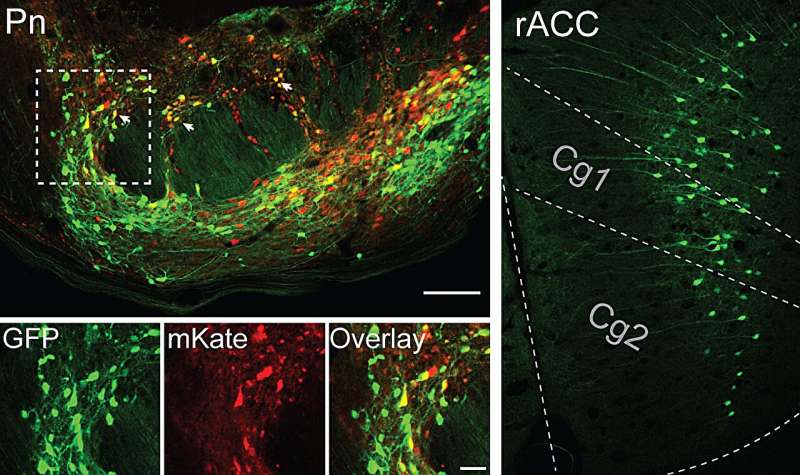This article has been reviewed according to Science X's editorial process and policies. Editors have highlighted the following attributes while ensuring the content's credibility:
fact-checked
peer-reviewed publication
trusted source
proofread
Neuroscientists discover brain circuitry of placebo effect for pain relief

The placebo effect is very real. This we've known for decades, as seen in real-life observations and the best double-blinded randomized clinical trials researchers have devised for many diseases and conditions, especially pain. And yet, how and why the placebo effect occurs has remained a mystery. Now, neuroscientists have discovered a key piece of the placebo effect puzzle.
Publishing in Nature, researchers at the University of North Carolina School of Medicine—with colleagues from Stanford, the Howard Hughes Medical Institute, and the Allen Institute for Brain Science—discovered a pain control pathway that links the cingulate cortex in the front of the brain, through the pons region of the brainstem, to cerebellum in the back of the brain.
The researchers, led by Greg Scherrer, PharmD, Ph.D., associate professor in the UNC Department of Cell Biology and Physiology, the UNC Neuroscience Center, and the UNC Department of Pharmacology, then showed that certain neurons and synapses along this pathway are highly activated when mice expect pain relief and experience pain relief, even when there is no medication involved.
"That neurons in our cerebral cortex communicate with the pons and cerebellum to adjust pain thresholds based on our expectations is both completely unexpected, given our previous understanding of the pain circuitry, and incredibly exciting," said Scherrer. "Our results do open the possibility of activating this pathway through other therapeutic means, such as drugs or neurostimulation methods to treat pain."
Scherrer and colleagues said research provides a new framework for investigating the brain pathways underlying other mind-body interactions and placebo effects beyond the ones involved in pain.
The placebo paradox
It is the human experience, in the face of pain, to want to feel better. As a result—and in conjunction with millennia of evolution—our brains can search for ways to help us feel better.
It releases chemicals, which can be measured. Positive thinking and even prayer have been shown to benefit some patients. And the placebo effect—feeling better even though there was no "real" treatment—has been documented as a very real phenomenon for decades.
In clinical research, the placebo effect is often seen in what we call the "sham" treatment group. That is, individuals in this group receive a fake pill or intervention that is supposed to be inert; no one in the control group is supposed to see a benefit. Except that the brain is so powerful and individuals so desire to feel better that some experience a marked improvement in their symptoms.
Some placebo effects are so strong that individuals are convinced they received a real treatment meant to help them.
In fact, it's thought that some individuals in the "actual" treatment group also derive benefit from the placebo effect. This is one of the reasons why clinical research of therapeutics is so difficult and demands as many volunteers as possible so scientists can parse the treatment benefit from the sham.
One way to help scientists do this is to first understand what precisely is happening in the brain of someone experiencing the placebo effect.
Enter the Scherrer lab
The authors of the Nature paper knew that the scientific community's understanding of the biological underpinnings of pain relief through placebo analgesia—when the positive expectation of pain relief is sufficient for patients to feel better—came from human brain imaging studies, which showed activity in certain brain regions.
Those imaging studies did not have enough precision to show what was actually happening in those brain regions. So Scherrer's team designed a set of meticulous, complementary, and time-consuming experiments to learn in more detail, with single nerve cell precision, what was happening in those regions.
First, the researchers created an assay that generates in mice the expectation of pain relief and then a very real placebo effect of pain relief. Then the researchers used a series of experimental methods to study the intricacies of the anterior cingulate cortex (ACC), which had been previously associated with the pain placebo effect.
While mice were experiencing the effect, the scientists used genetic tagging of neurons in the ACC, imaging of calcium in neurons of freely behaving mice, single-cell RNA sequencing techniques, electrophysiological recordings, and optogenetics—the use of light and fluorescent-tagged genes to manipulate cells.
These experiments helped them see and study the intricate neurobiology of the placebo effect down to the brain circuits, neurons, and synapses throughout the brain.
The scientists found that when mice expected pain relief, the rostral anterior cingulate cortex neurons projected their signals to the pontine nucleus, which had no previously established function in pain or pain relief. And they found that expectation of pain relief boosted signals along this pathway.
"There is an extraordinary abundance of opioid receptors here, supporting a role in pain modulation," Scherrer said. "When we inhibited activity in this pathway, we realized we were disrupting placebo analgesia and decreasing pain thresholds. And then, in the absence of placebo conditioning, when we activated this pathway, we caused pain relief."
Lastly, the scientists found that Purkinje cells—a distinct class of large branch-like cells of the cerebellum—showed activity patterns similar to those of the ACC neurons during pain relief expectation. Scherrer and first author Chong Chen, MD, Ph.D., a postdoctoral research associate in the Scherrer lab, said that this is cellular-level evidence for the cerebellum's role in cognitive pain modulation.
"We all know we need better ways to treat chronic pain, particularly treatments without harmful side effects and addictive properties," Scherrer said. "We think our findings open the door to targeting this novel neural pain pathway to treat people in a different but potentially more effective way."
More information: Grégory Scherrer, Neural circuit basis of placebo pain relief, Nature (2024). DOI: 10.1038/s41586-024-07816-z. www.nature.com/articles/s41586-024-07816-z


















